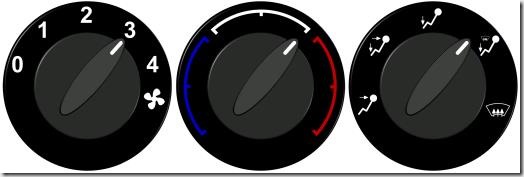I’ve had a run of hits recently on the search term “how do I turn on the car heater”. The most obvious answer to this is: READ THE OWNER’S MANUAL. If your car doesn’t have one (it’s usually in the glove box or under a flap somewhere beneath the dashboard) you can easily download them off the internet.
Even without a user manual, though, the controls are pretty much self-explanatory. You usually have three rotary knobs – one for the fan speed, one for the temperature, and one to change the direction of the airflow from the fan.
The fan controller has several speeds, usually ranging from 0 (off) to 4 (maximum). The temperature controller is marked with blue (cool) and red (hot) markers, and by adjusting it you can set the mix of cool/hot air to get the right overall temperature blowing in through the vents.
The direction controller has a number of icons on it similar to those shown below.
From left to right, these represent the air blowing at the driver/passenger out of the dashboard vents, air blowing from both the dashboard and foot well vents, air blowing only into the foot well, air blowing into the foot well and through the windscreen vents, and air blowing only through the windscreen vents. Some vehicles may have other icons, but they will usually be self-explanatory if you understand the ones above. The dashboard air vents have baffles on them which can be closed or angled to adjust the airflow as necessary.
Note that the coolest air that the car can deliver using the basic heater system will be at the same temperature as the outside air, so if it’s 30°C outside then the air blowing through the vents will also be at 30°C. There will also be some ambient heating from the engine, which will be most noticeable when the car is stationary or moving slowly, so the incoming air may actually be several degrees above the outside air temperature.
Most modern cars have air conditioning, which is turned on/off using a button or switch marked “A/C”. This is capable of cooling the air down to substantially below the outside air temperature. The A/C unit also dehumidifies the incoming air, which is useful for preventing misting of your windows during cold weather, but it has the disadvantage of dehydrating the occupants of the car if it is left on all the time (it can lead to irritation of your eyes and throat).
Modern high-end cars have computerised “climate control” systems handling the airflow, often with some sort of visual display. With these it is possible to set different temperatures for the driver and passenger and – usually – the back seat passengers, too. They still use similar icons to what I’ve described above, though the precise mode of operation varies from vehicle to vehicle.
Most vehicles will also have a recirculation button (marked with a curved arrow or similar icon). This adjusts the internal baffles so that little or no outside air is directed into the car. It is useful if you drive through smoke or perhaps if you suffer from hay fever (though most cars these days have pollen filters), or if there is a bad smell outside.